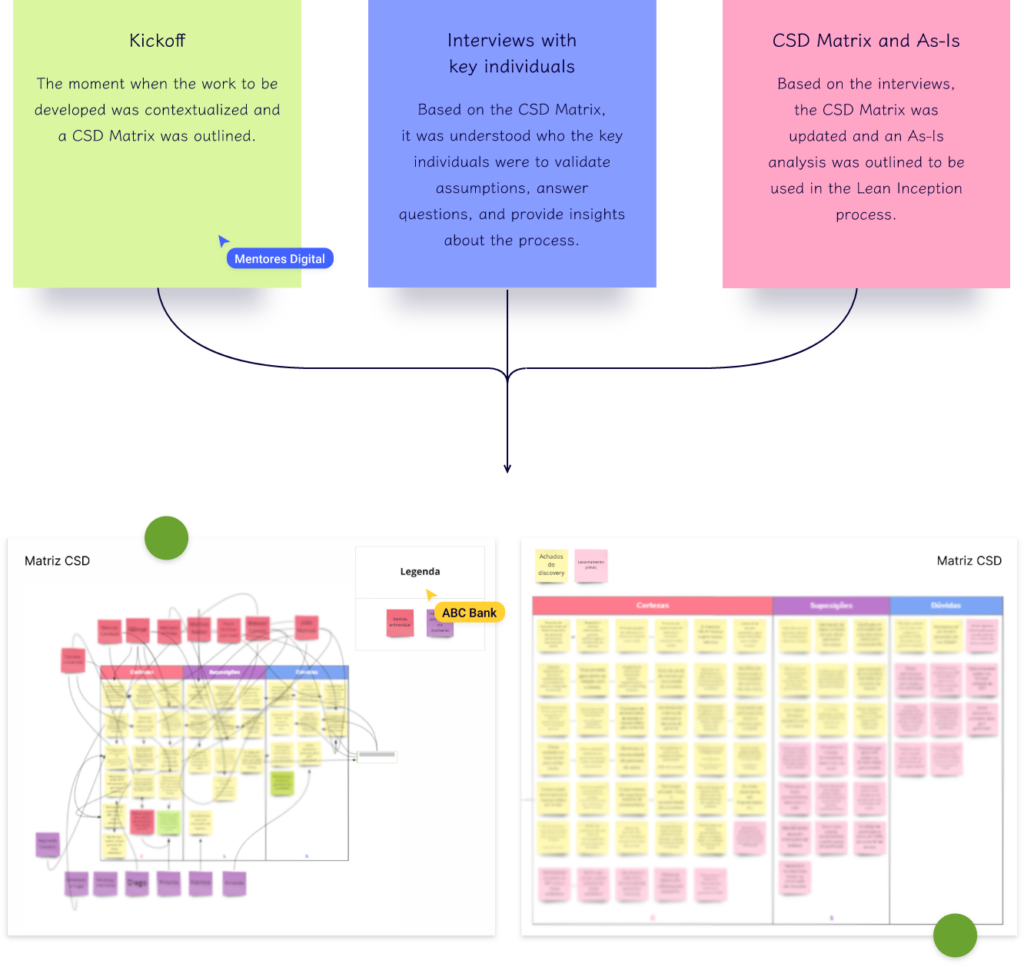were used to align people and think of
practical solutions to complex problems.
Country
Brazil
Year
2022
01. THE CHALLENGE
To build the digital transformation backlog of a bank, optimizing its credit and collection system with process improvements, automation, and integrations. All this considering alignment between different areas and an intelligent prioritization of actions.
02. THE PROBLEM
The process of purchase and maintenance of collaterals, as well as the implementation of collection was a process that generated conflicts and dissatisfaction to the user, mainly regarding the validation of the invoices provided as collateral, the transparency of the process to the user and officers, and the implementation of collection layout standards.
In addition to this problem for the user, the teams had manual processes of communication and of process status updates, as well as troubles when looking at the problem in a systemic way, submitting solutions focused on a punctual view of the problem.

03. THE SOLUTION
The problem submitted by Banco ABC is complex and with great impact to the organization. Based on that, a solution focused on UX Research, alignment and co-creation was proposed, through a Lean Inception and a pre-workshop discovery process.
The pre Lean Inception discovery was applied due to the project having a low level of clarity and a high level of uncertainty, allowing to align and collect information about the process and organize a pre-map of this process to be worked on during the Lean Inception.
Lean inception was chosen for being a powerful workshop to align several teams and stakeholders to think about a complex problem and organize the MVP of a solution.
The workshop was developed over 9 days, addressing UX, Business and Technology to organize a backlog for an MVP:




The proposed solution offers:
Time Gain and Investment Reduction
Fail fast, fail better!
Validating a product, process, or service guarantees savings in time and effort, and consequently, in investment.
User-centered Creation
It allows building a solution with user-centered thinking, which reduces errors and increases adherence and value deliverance.
Increased Alignment
Mitigation of divergences and increase of the feeling of belonging in the solution generated from a process that gathers the various actors involved in the problem in the creation of the solution.
04. THE PROCESS
UX Research
It is crucial for mapping pains and designing good experiences.
Before starting Lean Inception, an investigation about the current process of acquiring and maintaining credit was carried out in order to understand the context and start sketching pains and a process journey.
This process consists of the following steps:

User research is a basic principle of user-centered thinking, since understanding the user journey through a research process directs to assertive work on the right problems, since it is possible to predict the user’s vision without having to build a solution (as in a conventional process).
Lean Inception
Lean Inception is a co-creational workshop with the purpose of aligning a group of people to a problem, as well as developing and prioritizing a solution to be developed.
By the book, the workshop lasts 5 days structured in several activities that go from understanding the business, the user and the technology to prioritizing the product to be developed.
This methodology was used at Banco ABC to map the pains and think of solutions relevant to the collateral and collection sectors and related to the credit request and maintenance journey.
Due to the complexity of the presented problem, an extended workshop with times for designing was held to understand the problem in depth and plan the best solutions.

Day 1
On the first day, the purpose was to align the participants about the objectives of Lean Inception, the workshop schedule and functioning, and to introduce the working group, this stage is called kickoff.
In addition, a glossary of technical terms was created to align the language used by all, as well as to stimulate that this material be updated and referred to during the workshop.
We also carried out activities aimed at planning everyone’s understanding about the business vision of the problem and the expected solution. This stage consisted of the following activities
Product Vision: in which we aligned the expectation of the product that was desired to be built;
Is / Is not / Does / Does not: in which we align what the product we should develop and what it is not, as well as what it should do and what it should not do.




















